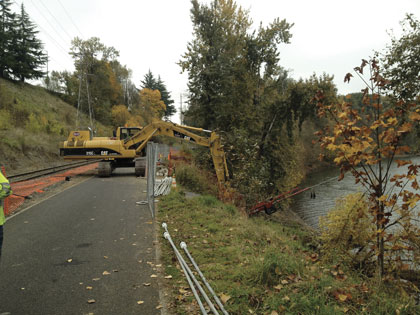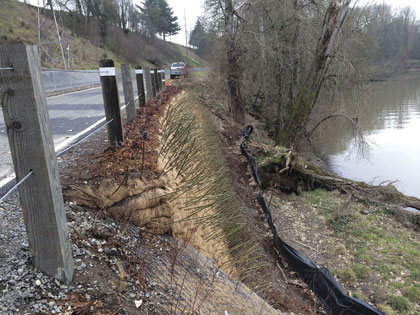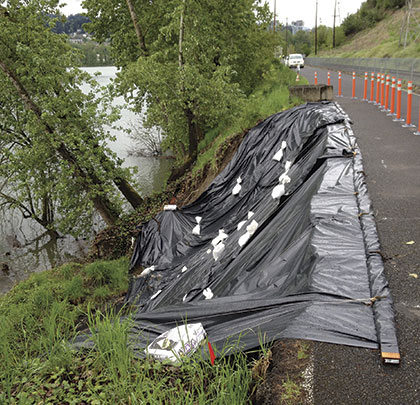The Springwater Corridor Bike Path is a very popular bicycle commuting thoroughfare extending along the east bank of the Willamette River in downtown Portland, Oregon. The path was constructed on the lower terrace of the Willamette River bank adjacent to an existing private railroad. The bank’s alluvial soils are continually subjected to transient raising and lowering of the river level and erosional forces which combine to remove buttress soils and create localized landslides. In the spring of 2012, an approximate 80-foot long section of the bank failed and resulted in the loss of approximately 4 feet of asphalt and shoulder.
FINDING THE SOLUTION
GeoStabilization International® (GSI®) was contacted by City of Portland Parks and Recreation to evaluate potential solutions not only to stabilize the existing unstable slope, but also reconstruct the path and shoulder that had failed into the river below. The potential stabilization options were also required to adhere to strict environmental regulations and meet the goals of the City of Portland Greenway Code. The initial phase of the project was also limited to construction related activities above Ordinary High Water Elevation (OHWE) to allow project commencement prior to Corps of Engineer permit acquisition.
GSI’s Engineering Group developed a repair plan consisting of a Launched SuperNails® and high strength galvanized mesh reinforced slope along with a Geosynthetically Confined Soil (GCS) Biowall® on a Launched SuperMicropileTM supported pile cap. Launched SuperNails stabilized the oversteepened headscarp and the Launched SuperMicropile provided axial support and scour protection for the Geosynthetically Confined Soil Biowall foundation. All construction related activities were completed with equipment positioned at the top of the slope and foot traffic above the OHWE.

Featured Image: In the spring of 2012, an approximate 80-foot long section of the bank failed and resulted in the loss of approximately 4 feet of asphalt and shoulder.
Above: GSI’s Engineering Group developed a repair plan consisting of a Launched SuperNails® and high strength galvanized mesh reinforced slope along with a Geosynthetically Confined Soil (GCS) Biowall® on a Launched SuperMicropileTM supported pile cap.
IDEAL FOR THE ENVIRONMENT
The Soil Nail Launcher™ was identified as an ideal tool for the environmental and in-water work restrictions. Originally developed by the British military to launch chemical weapons, the Soil Nail Launcher is a compressed air cannon that can accelerate a 1.5-inch diameter, 20-foot long steel or fiberglass tube to 250 miles per hour in a single shot. The Soil Nail Launcher had the ability to install the Launched SuperNails while working from the existing trail platform. There is also a lack of soil spoils that are produced using traditional drilling methods.
Dynamic installation results in distinct benefits over conventional nailing techniques. First, as these high-speed projectiles enter the earth, they generate a shock wave that causes the soil particles to elastically deform or “jump away” from the nail tip. The bars enter the earth without significant abrasion or loss of exterior corrosion protection. The soil particles then collapse onto the bar in a relatively undisturbed state, yielding pullout capacities up to 10 times that of driven or vibrated rods or tubes. Lastly, Launched Soil Nails increase soil density in the nailed area. In contrast, conventional open-hole drilling techniques allow the soil to relax prior to installation, which can adversely affect bond capacity.
Launched Soil Nails also can be perforated to allow for horizontal drainage and pore water pressure relief, and are the only technology available that provides continuous axial capacity and drainage with the same element. Alternately, the perforated nails can be pressure grouted with a variety of materials to increase bond capacity and soil properties throughout the nailed region. Once pressure grouted, an epoxy-coated inner bar can be installed inside the tube, creating a robust, corrosion resistant Launched SuperNail.

The facing of the GCS Biowall® consisted of geosynthetic bags filled with topsoil and faced with a turf reinforcement mat, with more than 700 live willow stakes planted.
REBUILDING THE PATH
The primary purpose of the GCS Biowall was to rebuild the bike path width that was lost during the slope failure. GCS retaining wall technologies are ideal when limited length is available for fabric reinforcement. The base to height ratio (ratio of fabric reinforcement length to retaining wall height) of GCS composites may be reduced to 0.2 if global stability is satisfied. In this case, global stability of the slope and retaining wall were satisfied with the Launched SuperNail and Launched SuperMicropile arrays. The key to GCS performance is close (8 inch) reinforcement spacing with compacted granular backfill. The reinforcement induces confining effects in the soil up to 4 inches from each sheet. That confining effect explains why GCS structures built with even the lightest fabrics can withstand loads up to 22.5 tons per square foot.
The facing of the GCS Biowall consisted of geosynthetic bags filled with topsoil and faced with a turf reinforcement mat. Over 700 live willow stakes were planted within the facing bags to provide a native aesthetic that met the goals of the City of Portland Greenway Personnel.

GSI field personnel successfully completed the project while maintaining full public access during normal commuting hours and weekends.
PROJECT COMPLETE
GSI field personnel successfully completed this challenging project while maintaining full public access during normal commuting hours and weekends. The City of Portland Parks and Recreation plans a second phase of bank stabilization work after Corps of Engineers permit acquisition to further enhance the native vegetation and wildlife habitat below the foundation of the Biowall. ■
For More Information: GeoStabilization International® is the leading geohazard mitigation firm operating throughout the U.S. and Canada. Its patented tools include the Soil Nail Launcher™, the Biowall® System, ScourMicropiles™, and SuperNails®, all of which is installed using a combined fleet of over 50 purpose-built Soil Nail Launchers™ and purpose-built limited access drill rigs. For more information, visit www.geostabilization.com.
_________________________________________________________________________
Modern Contractor Solutions – August 2016
Did you enjoy this article?
Subscribe to the FREE Digital Edition of Modern Contractor Solutions magazine.

Path Reconstruction


